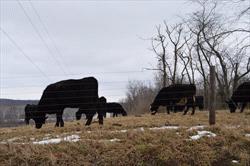Bob Judd, DVM, DABVP (Equine Medicine), DABVP (Canine and Feline Practice)
cows and snow1.JPG

In Feedlot Magazine.com, Dr. Bob Larson, DVM, talks about what he refers to as winter cow syndrome. Winter cow syndrome is a term used to describe individual cows or even groups of cows that experience a significant decline in body weight and condition over the winter. These cows can become very thin, and some will not survive the winter.
Cows over ten years old are at a higher risk of winter cow syndrome because older cows have poor teeth for chewing hay. They may maintain their body weight on good pasture in the spring and summer but usually lose weight on a hay-only diet.
Heifers that are still growing and need more energy than hay can provide may also develop winter cow syndrome. Certainly, any animal with an infection or parasites will be susceptible.
Many of these cows are fed poor quality hay that is poorly digestible, as this type of hay often has a high lignin content (an organic compound that binds to cellulose fibers to harden the cell walls of plants, making hay “woody”), low energy, and low protein and passes through the gastrointestinal tract slowly. Because of this, cows cannot eat enough of poor-quality forage to get all the nutrients needed, and they lose weight.
Mature forages are also deficient in phosphorus, calcium, and vitamin A, as calcium and phosphorus levels decrease in hay during the winter.
The greatest weather distress is when cows become wet or muddy.
Cows do well in the winter if they have a dry haircoat and adequate body fat, as cows in good condition will require 1% more energy for each degree of environmental temperature below a wind chill of 32 F degrees.